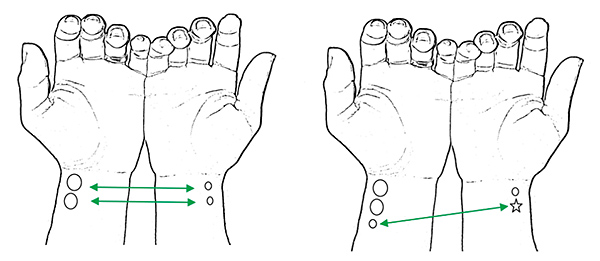Frozen shoulder, also referred to as wu shi jian (50-year shoulder) in Chinese, is a common clinical presentation in women of menopausal age marked by decreased range of shoulder motion and discomfort with movement of the shoulder joint.
Diagnostic imaging of the shoulder joint yields indefinite etiology, but can eliminate the possible of fracture, dislocation or tendinous tears. Distinction between frozen shoulder and other shoulder-related syndromes is frequently inhibited without direct access to diagnostic imaging. Needle insertion in one or more acupuncture points of the upper extremity significantly contributes to distinction and prognosis of this syndrome.
 The Hwa-Chim Five Elemental Acupuncture method, herein referred to as HAT, was utilized in this case study to examine and determine prognosis of a female patient, age 54, who complained of sharp pain and restricted movement of her left arm.
The Hwa-Chim Five Elemental Acupuncture method, herein referred to as HAT, was utilized in this case study to examine and determine prognosis of a female patient, age 54, who complained of sharp pain and restricted movement of her left arm.
Presentation / Examination
Amanda, age 54, complained of left shoulder pain radiating from her acromial extremity to medial deltoid tendon with the arm laterally abducted. Her shoulder pain was inconsistent and unnoticeable when sitting or standing with her arm relaxed; but acutely exacerbated with specific movements. Shoulder movement was aided by excess rotation of the scapula and Amanda was incapable of isolated abduction.
Positive empty-can test and reduced ROM suggested supraspinatus involvement. Without a formal diagnosis of shoulder injury, I inserted a HAT test point followed by ROM examination to determine if a significant tear was present. To carry out this test, her five-elemental constitution was determined using the HAT pulse comparison method.
Determining the Patient's Five-Elemental Constitution
According to this method, the cun, guan and chi positions of both wrists are compared to determine relatively stronger and weaker pulses along the controlling cycle. Each controlling cycle pulse pattern reveals a hierarchy of organ strength and is associated with one of five elemental constitutions, also referred to as the FEC (five-elemental constitution).
HAT treatment is primarily focused on balancing the excess and deficient elements of each of the FECs:
- Wood excess metal deficiency
- Fire excess water deficiency
- Earth excess wood deficiency
- Metal excess fire deficiency
- Water excess earth deficiency
Amanda's pulse pattern indicated she was a wood excess metal deficiency FEC, determined by comparing the heart fire and lung metal pulses in the cun position. In a wood excess FEC, the heart pulse is stronger than the lung pulse. In the guan position, the liver wood pulse is stronger than the spleen earth pulse. Finally, the spleen pulse is compared to the kidney water pulse in the chi position. In a wood excess FEC, the spleen pulse is stronger than the kidney pulse.

Meridian Involvement
Next, I determined which meridian flowing through the shoulder joint was primarily affected. In Amanda's case, acromial extremity and medial deltoid discomfort with abduction of the arm pointed to the large-intestine channel. According to HAT, if yin is tonified, then yang should be sedated; and if yang is tonified, then yin should be sedated. Hence, in the wood excess scenario, LI 1 (Shangyang; yang metal point on yang metal channel) should be sedated to control wood excess. Sedation of LI 1 was therefore performed as the first point to determine extent of injury and range of motion.
The jing well points are commonly incorporated to reduce pain and strongly stimulate the flow of qi along correlated acupuncture channels. Hence, jing well points can be utilized as "tester" points, often producing immediate ROM effect in patients without significant rotator-cuff tear.
Treatment Steps
After sedating the LI 1 acupuncture point, I asked Amanda to abduct her fully extended left arm as far as possible above her head. After three attempts, she was able to extend her arm without discomfort to 175 degrees (equal to the range of motion of her unaffected arm). I therefore concluded that a significant tear was unlikely.
Amanda was instructed to lie down with the LI 1 acupuncture point inserted and treatment was commenced by inserting the four standard wood excess FEC points:
- Tonify LU 8 (jingqu; metal point on metal channel)
- Sedate HT 8 (shaofu; fire point on fire channel)
- Tonify KD 10 (yingu; water point on water channel)
- Sedate LIV 1 (dadun; wood point on wood channel)
She was also told to carefully abduct her arm every few minutes during the 30-minute acupuncture session.
Clinical Considerations
Inaccurate distinction of the patient's elemental constitution is the most common reason why results may not be detected. Determining the relative strength of each pulse requires practice and precision; thus, pulse examination is often repeated. The second most common reason is lack of precise needle insertion. Both scenarios require pulse re-examination and/or acupuncture needle reinsertion.
The third possible reason involves point insertion along an unaffiliated meridian. Finally, if ROM doesn't improve after careful implementation of the above steps, then orthopedic referral is warranted. Moreover, this method of examination and treatment should only be implemented in cases that do not require emergency care. Symptoms will not improve with significant or complete rotator-cuff tears.
The HAT method rapidly improved Amanda's shoulder ROM and decreased frozen shoulder syndrome-related discomfort. This method is not, however, sustainable without incorporating range-of-motion exercises and stretches during and in between sessions. Without supplemental therapy and exercise, shoulder symptoms have a tendency to regress between treatments.
The use of HAT in conjunction with stretching and ROM exercises is recommended in patients with mild to acute loss of ROM and stiffness of the shoulder joint. HAT may also serve as a viable method of distinguishing between ROM loss due to inflammation and significant tear of the rotator-cuff tendons.
Gary Wagman is the author of Your Yin Yang Body Type – The Korean Tradition of Sasang Medicine. He is also a doctor of psychology and practitioner of Oriental Medicine, living in Portland, Oregon. More information about Dr. Wagman and the Yin Yang Body Types can be found on www.sasangmedicine.com.



